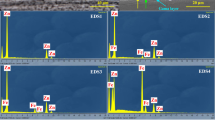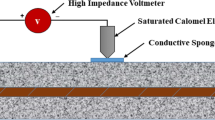Abstract
Corrosion products on 23 bronze dagger-axes unearthed from different tombs dating to the Warring States period at Yujiaba site, Kai County, Chongqing, China, were characterized non-destructively by Raman spectroscopy and optical microscopy (OM). The results showed that Cu corrosion products such as Cu hydroxide sulfate, Cu hydroxide carbonate, Cu hydroxide phosphate, Cu chloride hydroxide, Cu sulfide, Cu oxide, Pb corrosion products such as Pb oxide, Pb carbonate and Pb chlorine phosphate/arsenate (Pb5((As,P)O4)3Cl), and Sn oxide were all detected. Of 23 bronze dagger-axes, 15 were found with mimetite-pyromorphite, whereas 2 with Cu chloride hydroxide may indicate that chlorine ion can combine with Pb more easily than Cu in this special environment. Sulfate ion, phosphoric ion, chloride ion, carbonate ion or bicarbonate ion, and microorganism in the buried environment are the main factors which influenced the formation of corrosion products. Because these bronze dagger-axes were all unearthed in the tombs, the phosphoric ion in the buried environment should come from hydroxyapatite (Ca5(PO4)3OH) which is the main inorganic phase of human bones and teeth in the tombs.







Similar content being viewed by others
References
Archaeology Department of Shandong University (1999) Brief report on the excavation of Yujiaba site, Kai County, Sichuan province. Archaeology 1:53–58 (in Chinese with English Abstract)
Bajda T, Mozgawa W, Manecki M, Flis J (2011) Vibrational spectroscopic study of mimetite–pyromorphite solid solutions. Polyhedron 30:2479–2485
Berger D, Berthold C, Bunnefeld JH, Keuper M (2016) A mysterious black ornamentation on an early bronze age dagger from Schoolbek (Kosel), Schleswig-Holstein, Germany. J Archaeol Sci Rep 5:407–421
Bertolotti G, Bersani D, Lottici PP, Alesiani M, Malcherek T, Schlüte J (2012) Micro-Raman study of copper hydroxychlorides and other corrosion products of bronze samples mimicking archaeological coins. Anal Bioanal Chem 402:1451–1457
Bouchard M, Smith DC (2003) Catalogue of 45 reference Raman spectra of minerals concerning research in art history or archaeology, especially on corroded metals and coloured glass. Spectrochim Acta A 59:2247–2266
Bruckner S, Lusvardi G, Menabue L, Saladini M (1993) Effect of Cu2+ ion on the structural stability of synthetic hydroxyapatite. J Mater Chem 3(7):715–719
Cultural Relics Heritage Bureau of Chongqing, Resettlement Bureau of Chongqing (2007a) Collections of reports on the archaeological excavation in the three Gorges Dam, Chongqing in 2001. Sciences Press, Beijing (in Chinese)
Cultural Relics Heritage Bureau of Chongqing, Resettlement Bureau of Chongqing (2007b) Collections of reports on the archaeological excavation in the three Gorges Dam, Chongqing in 2000. Sciences Press,Beijing (in Chinese)
Fabrizi M, Ganiaris H, Tarling S, Scott DA (1989) The occurrence of sampleite, a complex copper phosphate, as a corrosion product on copper alloy objects from Memphis, Egypt. Stud Conserv 34(1):45–51
Fan XP, Freestone IC (2017) Occurrence of phosphatic corrosion products on bronze swords of the Warring States period buried at Lijiaba site in Chongqing. China, Heritage Science 5:48–56
Fan XP, Zhao XW, Zhao Z, Wen XH (2017) SEM analysis of corrosion products on the bronze earcup of Han dynasty unearthed at Silibao site, Yunyang County. J Chin Electron Microsc Soc 36:259–263 (in Chinese with English Abstract)
Fan XP, Zhao XW, He BH, Yuan Q (2019) Analysis of Corrosion Products on Bronze Artifacts Dated to Western Han Dynasty Unearthed in Zhuanwaxi Site, Shizhu County, Chongqing. Corrosion Sci Protect Technol 31:1–7 (in Chinese with English Abstract)
Figueiredo J, Oliveira J, Souza G, Froner Y, Souza LAC, Zarankin A (2015) Characterization of corrosion products on metals excavated from seal hunters’ occupation in Antarctica in the eighteenth and nineteenth centuries. Stud Conserv 60(3):211–216
Frost RL, Kloprogge JT, Williams P (2003) Raman spectroscopy of lead sulphate-carbonate minerals: implications for hydrogen bonding. Neues Jahrbuch fuer Mineralogie-Monatshefte 12:529–542
Frost RL, Palmer S (2007) a Raman spectroscopic study of the phosphate mineral pyromorphite Pb5(PO4)3Cl. Polyhedron 26(15):4533–4541
Hayez V, Guillaume J, Hubin A, Terryn H (2004) Micro-Raman spectroscopy for the study of corrosion products on copper alloys: setting up of a reference database and studying works of art. J Raman Spectrosc 35:732–738
Huang Y, Zhang J, Huang Y, Lu J, Mao Z (1991) The analysis of bronze arrowheads dated to the Western Zhou period unearthed in Dachengdun, Hanshan County. Kaogu 2:1134–1137 (in Chinese with English Abstract)
Ingo GM, Riccucci C, Faraldi F, Casaletto MP, Guida G (2010) Micro-chemical and micro-structural investigation of the corrosion products on “the dancing satyr” (Mazara del Vallo, Sicily, Italy). Applied Physics A 100:785–792
Ivanda M, Waasmaier D, Endriss A, Ihringer J, Kirfel A, Kiefer W (1997) Low-temperature anomalies of cuprite observed by Raman spectroscopy and X-ray powder diffraction. J Raman Spectrosc J Raman Spectrosc 28:487–493
Kharbish S, Andras P, Luptáková J, Milovská S (2014) Raman spectra of oriented and non-oriented Cu hydroxy-phosphate minerals: Libethenite, cornetite, pseudomalachite, reichenbachite and ludjibaite. Spectrochim Acta A Mol Biomol Spectrosc 130:152–163
Ma YR (2010) The corrosion products of bronzes and buried environment. In: In the 11th National symoposium on archaeology and conservation chemistry. Relics Press, Beijing, pp 105–107
Martens WN, Rintoul L, Kloprogge JT, Frost RL (2015) Single crystal Raman spectroscopy of cerussite. Am Mineral 89:352–358
Mattsson E, Nord AG, Tronner K, Fjaestad M, Lagerlof A, Ullen I, Brog GH (1996) Deterioration of archaeological material in soil results on bronze artefacts. Print Gotab, Stockholm
Muros V, Scott DA (2018) The occurrence of brochantite on archaeological bronzes: a case study from Lofkënd, Albania. Stud Conserv 63(2):113–125
Nriagu J (1973) Lead orthophosphates - II. Stability of cholopyromophite at 25 °C. Geochimica et. Cosmochimica Acta 37(3):367–377
Oriental Archaeology Research Center of Shandong University (2004) Cultural Bureau of Chongqing, Cultural Relics Heritage Center of Kai County. Jianhan Archaeol 3:37–48 (in Chinese with English Abstract)
Ospitali F, Chiavari C, Martini C, Bernardi E, Passarinic F, Robbiolad L (2012) The characterization of Sn-based corrosion products in ancient bronzes: a Raman approach. J Raman Spectrosc 43:1596–1603
Oudbashi O, Hasanpour A, Davami P (2016) Investigation on corrosion stratigraphy and morphology in some Iron Age bronze alloys vessels by OM, XRD and SEM–EDS methods. Applied Physics A 122:262–272
Piccardo P, Mödlinger M, Ghiara G, Campodonico S, Bongiorno V (2013) Investigation on a “tentacle-like” corrosion feature on bronze age tin-bronze objects. Appl Phys A Mater Sci Process 113:1039–1047
Rhee YJ, Hillier S, Gadd GM (2012) Lead transformation to pyromorphite by fungi. Curr Biol 22:237–241
de Ryck I, Adriaens A, Pantos E, Adams F (2003) A comparison of microbeam techniques for the analysis of corroded ancient bronze objects. Analyst. 128:1104–1109
Scott DA (1990) Bronze disease: a review of some chemical problems and the role of relative humidity. J Am Inst Conserv 29:2,193–2,206
Scott DA (2002) Copper and bronze in art: corrosion, colourants and conservation. Getty Publications, Los Angeles
Scott DA, Maish JP (2010) A Lydian bed of iron, bronze and copper. Stud Conserv 55:3–19
Scott DA (2017) New insights on the corrosion of ancient bronzes using X-ray powder diffraction: the importance of paratacamite, sampleite, and connellite. Stud Conserv 62(7):410–418
Wu MW, Higuchi W, Fox JL, Friedman M (1976) Kinetics and mechanism of hydroxyapatite crystal dissolution in weak acid buffers using the rotating disk method. J Dent Res 59(3):496–505
Yang XG (2013) A technical study of bronze from Three Gorges region between Eastern Zhou to Han Dynasty. Sciences Press, Beijing
Yao ZH (2006) A technical study of bronze from the Ba-Shu region in the 5–2 century B.C.E and a discussion on the surficial craft of weapon. Sciences Press, Beijing
Yu B, Fang J, Huang E (2013) Characteristics of the Raman spectra of archaeological malachites. J Raman Spectrosc 44:630–636
Zittlau AH, Shi Q, Boerio-Goates J, Woodfield BF, Majzlan J (2013) Thermodynamics of the basic copper sulfates antlerite, posnjakite, and brochantite. Chem Erde 73:39–50
Author information
Authors and Affiliations
Corresponding author
Additional information
Publisher’s note
Springer Nature remains neutral with regard to jurisdictional claims in published maps and institutional affiliations.
Rights and permissions
About this article
Cite this article
Fan, X., Wang, Q. & Wang, Y. Non-destructive in situ Raman spectroscopic investigation of corrosion products on the bronze dagger-axes from Yujiaba site in Chongqing, China. Archaeol Anthropol Sci 12, 90 (2020). https://doi.org/10.1007/s12520-020-01042-0
Received:
Accepted:
Published:
DOI: https://doi.org/10.1007/s12520-020-01042-0




